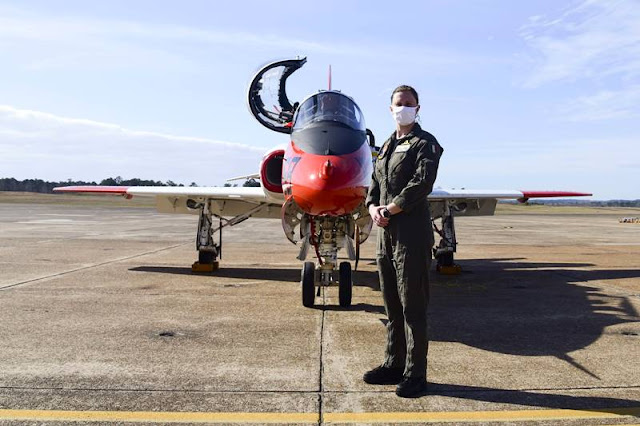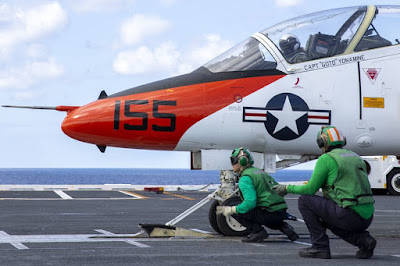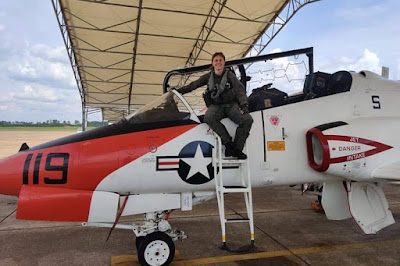First female Italian Navy strike fighter pilot earns Wings of Gold
She will learn to operate both F-35 Lightning II and AV-8B Harrier.
The Italian navy’s first female strike fighter pilot received her Wings of Gold after completing undergraduate flight training with the “Tigers” of Training Squadron (VT) 9 at Naval Air Station (NAS) Meridian, Mississippi, March 11.
Italian navy Ensign Erika Raballo was designated a naval aviator during a small winging ceremony at the base chapel with five classmates marking a significant milestone in Italian and U.S. Naval Aviation history and further strengthening the partnership between the two nations.
“We are all incredibly proud of Ensign Raballo,” VT-9 Commanding Officer Cmdr. Meghan Angermann said. “She has proven she is a capable, competent warfighter ready to take her strike aviation training to the next level. She and her classmates worked hard to get to this point and what they can and will accomplish in the future is limitless.”
Raballo conducted her final graded curriculum event in a T-45C Goshawk jet trainer aircraft March 10. She returned to her squadron mates waiting on the Training Air Wing 1 flight line for a traditional “soft winging” ceremony during which Angermann presented Raballo with a fabric patch emblazoned with the Wings of Gold.
“Being the first female Italian navy jet pilot is an amazing feeling,” Raballo said. “My desire is to be the first one of many and I hope I’ll be an inspiration for many other women in all lines of work, not because I’m special, but for the exact opposite; I came from a small town, with no military background whatsoever and with willingness and hard work I was able to make my dream come true.”
Raballo is from Alba in the commune of Piedmont in northwest Italy. Aside from her father and uncles’ compulsory one year of service, Raballo is the first in her family to dedicate her career to military service.
“I decided I wanted to be a pilot when I was 16 after visiting a joint naval and air force base,” Raballo said. “I was stunned by the words of the pilots and so fascinated by the introductory flight that we did on a navy helicopter that the following day I watched ‘Top Gun’ for the first time and I was all in!”
Each year, the Italian navy sends approximately 10 officers to the United States to begin pilot training under Chief of Naval Air Training. Italian navy Lt. Cmdr. Simone Pitto is a country liaison officer and oversees all Italian students in undergraduate flight training.
“In 2000, the Italian parliament approved the opening of the armed forces to women,” Pitto said. “After 20 years they [women] are fully integrated in all operational domains of the navy where they operate on surface ships, submarines, amphibious platoons, special forces, and helicopter squadrons. It is with great pride that now we see a woman also complete jet training and qualify as a STOVL (short take-off vertical landing) pilot. Ensign Raballo’s achievement is a testament to her intellect, skill, and determination to succeed.”
Before reporting to VT-9, Raballo completed primary flight training in T-6B Texan II turboprop trainer aircraft with the “Shooters” of VT-6 under Training Air Wing 5 at NAS Whiting Field in Milton, Florida.
Like her classmates, Raballo is part of a new generation of strike fighter pilots to qualify on state-of-the art Aircraft Launch and Recovery Equipment (ALRE) used on aircraft carrier USS Gerald R. Ford (CVN 78) and all future Gerald R. Ford-class carriers: the Electromagnetic Aircraft Launch System (EMALS) and Advanced Arresting Gear (AAG). She completed T-45C carrier qualifications on Ford in the Atlantic Ocean off the Florida coast, Feb. 5, which she said was her favorite part of the strike pilot training pipeline.
“Landing on the aircraft carrier for the first time was mind blowing,” Raballo said. “I was so nervous at first and I have to say thank you to my paddles (landing signals officers), Lt. Allen Vohden and Lt. Sean Lawrence, for all the patience and effort they put into preparing me skill wise and mentally for that big challenge.”
Raballo will continue to postgraduate training at one of two U.S. Marine Corps fleet replacement squadrons to learn to operate either the F-35 Lightning II or the AV-8B Harrier.
Italian navy Ensign Erika Raballo was designated a naval aviator during a small winging ceremony at the base chapel with five classmates marking a significant milestone in Italian and U.S. Naval Aviation history and further strengthening the partnership between the two nations.
“We are all incredibly proud of Ensign Raballo,” VT-9 Commanding Officer Cmdr. Meghan Angermann said. “She has proven she is a capable, competent warfighter ready to take her strike aviation training to the next level. She and her classmates worked hard to get to this point and what they can and will accomplish in the future is limitless.”
Raballo conducted her final graded curriculum event in a T-45C Goshawk jet trainer aircraft March 10. She returned to her squadron mates waiting on the Training Air Wing 1 flight line for a traditional “soft winging” ceremony during which Angermann presented Raballo with a fabric patch emblazoned with the Wings of Gold.
“Being the first female Italian navy jet pilot is an amazing feeling,” Raballo said. “My desire is to be the first one of many and I hope I’ll be an inspiration for many other women in all lines of work, not because I’m special, but for the exact opposite; I came from a small town, with no military background whatsoever and with willingness and hard work I was able to make my dream come true.”
Raballo is from Alba in the commune of Piedmont in northwest Italy. Aside from her father and uncles’ compulsory one year of service, Raballo is the first in her family to dedicate her career to military service.
“I decided I wanted to be a pilot when I was 16 after visiting a joint naval and air force base,” Raballo said. “I was stunned by the words of the pilots and so fascinated by the introductory flight that we did on a navy helicopter that the following day I watched ‘Top Gun’ for the first time and I was all in!”
Each year, the Italian navy sends approximately 10 officers to the United States to begin pilot training under Chief of Naval Air Training. Italian navy Lt. Cmdr. Simone Pitto is a country liaison officer and oversees all Italian students in undergraduate flight training.
“In 2000, the Italian parliament approved the opening of the armed forces to women,” Pitto said. “After 20 years they [women] are fully integrated in all operational domains of the navy where they operate on surface ships, submarines, amphibious platoons, special forces, and helicopter squadrons. It is with great pride that now we see a woman also complete jet training and qualify as a STOVL (short take-off vertical landing) pilot. Ensign Raballo’s achievement is a testament to her intellect, skill, and determination to succeed.”
Before reporting to VT-9, Raballo completed primary flight training in T-6B Texan II turboprop trainer aircraft with the “Shooters” of VT-6 under Training Air Wing 5 at NAS Whiting Field in Milton, Florida.
Like her classmates, Raballo is part of a new generation of strike fighter pilots to qualify on state-of-the art Aircraft Launch and Recovery Equipment (ALRE) used on aircraft carrier USS Gerald R. Ford (CVN 78) and all future Gerald R. Ford-class carriers: the Electromagnetic Aircraft Launch System (EMALS) and Advanced Arresting Gear (AAG). She completed T-45C carrier qualifications on Ford in the Atlantic Ocean off the Florida coast, Feb. 5, which she said was her favorite part of the strike pilot training pipeline.
“Landing on the aircraft carrier for the first time was mind blowing,” Raballo said. “I was so nervous at first and I have to say thank you to my paddles (landing signals officers), Lt. Allen Vohden and Lt. Sean Lawrence, for all the patience and effort they put into preparing me skill wise and mentally for that big challenge.”
Raballo will continue to postgraduate training at one of two U.S. Marine Corps fleet replacement squadrons to learn to operate either the F-35 Lightning II or the AV-8B Harrier.
Source, Images: US Navy Naval Air Training Command









No comments
All comments related to the contents of our articles are welcome. It is not allowed to post promotional messages, links to external sites, or references to activities not related to this blog.